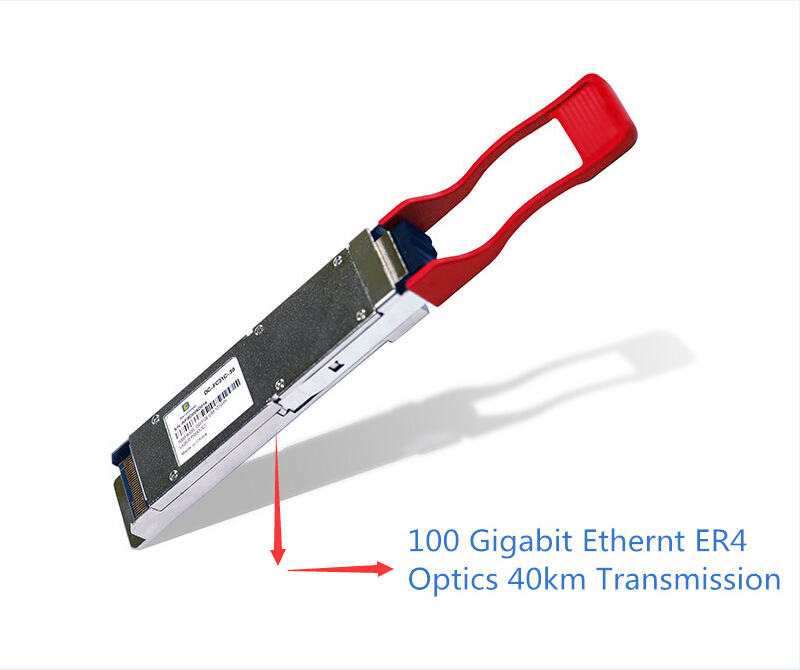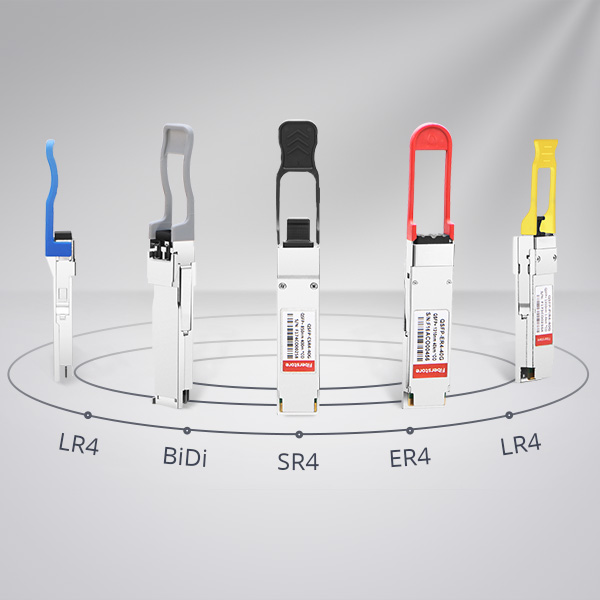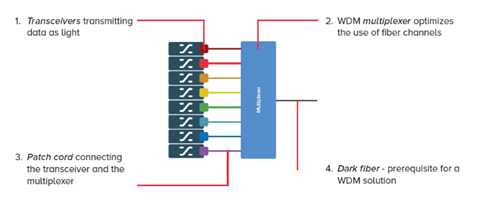October 20, 2017
Today’s world is undergoing an infrastructure transformation, which requires higher speed, greater scalability, higher performance, flexibility and reliability to meet the demands. Take 100G data rate as an example, the MSA groups keep driving development of 500m, 2km, 10km and 40km cost-effective 100G optics targeting modern data center. The 100G QSFP28 ER4-Lite standard was sampling several months ago, but now we are glad to announce that 100G QSFP28 ER4 modules are available in several vendors, e.g. FS.COM, Flexoptics, Smartoptics, etc. Today’s article will explain this long-reach 100G optics in detail.
How Does It Develop?
A heated topic—how to reach beyond 10km in 100G network aroused much attention in Reddit. For applications beyond 10km, 100GBASE-ER4 is proposed. This type of optical transceivers are manufactured by using a semiconductor amplifier (SOA) inside the transceiver to increase power budget. However, 100G ER4 is available in CFP and CFP2 form factors, but because of the large form factor and power consumption, they are seldom utilized in 100G long-reach applications. What’s worst, the newly launched 100G optical switches are commonly equipped with compact QSFP28 ports instead of larger CFP interface.
These extended reaches are preferring to use high-density 100G QSFP28 modules to maximum capacity and minimize space, power usage and maintenance cost. The CWDM4 MSA defined the first duplex low-cost 100G specification for 2km reaches based on a CWDM grid and using RS (528,514) FEC. Now the 4WDM MSA is extending the value proposition of the CWDM4 MSA and RS-FEC to define an even more cost-effective set of specifications for reaches from 10 to 40 km. Customers, particularly hyperscale cloud service providers and carriers, are looking for optimized solutions for up to 40 km.
What’s New with QSFP28 ER4-Lite Solution?
QSFP-100G-ER4L-S is designed for extended reach 100 Gigabit Ethernet link. The 100GBASE-ER4-Lite QSFP28 supports both 100GbE and OTU4 applications over single-mode fibers, and supports up to 40km with FEC and up to 30km without FEC. 100G QSFP28 ER4 Lite module consumes 4.5W power in max.
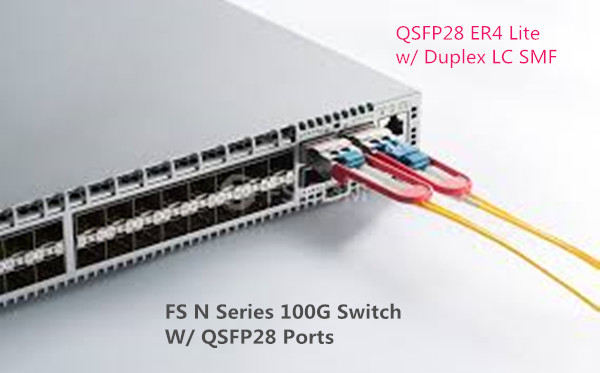
The 100 Gigabit Ethernet signal is carried over four independent channels over four LAN-WDM wavelengths—1296nm, 1300nm, 1305nm, 1309nm. Multiplexing and demultiplexing of the four wavelengths are managed within the device. This QSFP28 was standardized by ITU-T as G.959.1 4L1-9D1F and 4-Wavelength WDM MSA Group. The following table displays the existing 100G QSFP28 MSA optics in detail.
| Product | Description | Connector Type |
| QSFP-100G-SR4-S | 100GBASE SR4 QSFP Transceiver, 100m over OM4 MMF | MPO-12 (12 fibers) |
| QSFP-100G-LR4-S | 100GBASE LR4 QSFP Transceiver, 0km over SMF | LC |
| QSFP-100G-CWDM4-S | 100GBASE CWDM4 QSFP Transceiver, 2km over SMF | LC |
| QSFP-100G-PSM4-S | 100GBASE PSM4 QSFP Transceiver, 500m over SMF | MPO-12 (12 fibers) |
| QSFP-100G-ER4L-S | 100GBASE ER4 Lite QSFP Transceiver, 25-40km over SMF | LC |
The 100G QSFP ER4-Lite module will interoperate with existing ER4 solutions in the field up to 30km. Foe example, QSFP100 ER4-Lite provides backward compatibility with Cisco’s CPAK ER4-Lite, whose reach is up to 25km, and with IEEE 100GBASE-ER4 standardized transceivers, such as CFP 100G ER4, up to 30km. It also interoperates with QSFP28 and CPAK IEEE 100GBASE-LR4 modules up to 10km.
40km Transmission With FEC Turn On
To reach 40km transmission, QSFP ER4 lite requires the use of FEC on the host platform. So what is FEC? Forward Error Correction (FEC) can turn a mediocre to bad BER into a good BER. Ethernet network usually uses FEC in 1000BASE-PX (EPON), 10GBASE-KR, 10GEPON, 10GBASE-T, DSL, etc. High end long haul telecom industry also requires FEC. P802.3ba links have limited power budgets and SNR, for e.g. eye safety reasons.
Conclusion
The migration of current network infrastructure to 100G systems is inevitable, and a growing number of enterprises require 100G client interface to extend up to 40km without the use of expensive optical amplifiers. Thus, the new ER4-Lite specification enables cost-effective 100G 40km pluggable solutions in compact QSFP28 transceivers that use Forward Error Correction (FEC) and APD-based receivers. Such evolution is very exciting for not only everyone involved in its development and construction, but also for all those who seek a simple, reliable and cost-effective solution to extend the reach of their networks, without expensive network upgrades. FS.COM is devoting to change the world with our cost-effective self-developed devices, if you are interested, please feel free to contact us.
Posted by: fernxu123 at
04:29 AM
| Comments (7)
| Add Comment
Post contains 707 words, total size 7 kb.
October 12, 2017
Thanks to the complexity of the fiber optic installation and audio video system, the need for sending multiple signal types and control over long distances has increasingly become intense. Ethernet cables like Cat 5e, Cat 6 and Cat 7, is an indispensable component for home or small business. Nowadays most manufacturers will recommend the use of solid shielded Cat 6 cable with shielded connectors other than using the HDBASE-T chipset for signal extension. This type of cable can be terminated in the field or purchased in specific lengths already terminated. The following article provides a brief introduction to the reasons why we should use Pre-terminated Cat 6 cables for the signal extension.
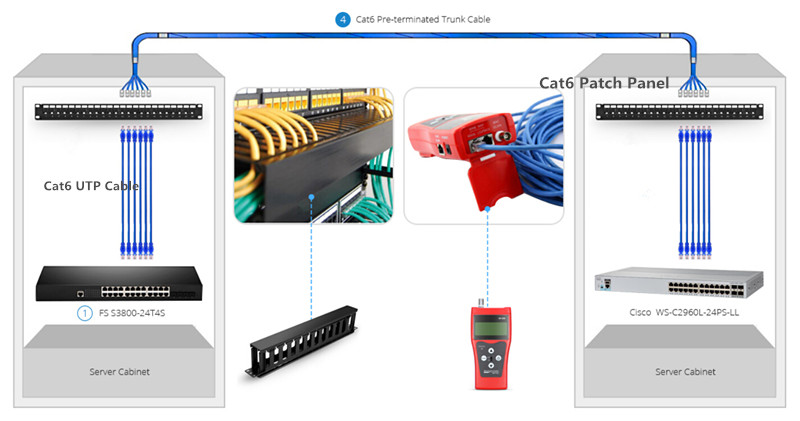
Figure 1 shows the UTP Cat6 cables, Pre-terminated trunk cables, FS optical switches, cable manager wire duct.
Brief Outlook: Cat 6 Over Cat5 Cable
Cat5 and Cat6 copper Ethernet cables are the commonly used types for 1G/10G networks. So, what is the benefit of using Cat 6 cable instead of Cat 5?
In short, Cat 5e is a basic wire for home network. It is typically 24 gauge and can run 10 Gigabit network for 328 ft. While Cat 6 was developed to have 10 Gigabit networks. The only problem is that these wires were limited to a range of 164 feet. Above this, their speed will drop to 1Gbqs.
Besides distance and speed, Cat 6 patch cable also has another important difference, it has tighter twists in the cables. This allows each pair of wires to have two-way communication with each other. Cat 5e has an occasional delay and a higher skew than Cat 6 does. This means that even though Cat 5 can run at a speed of a Gigabit, it will appear to be slower.
Pre-terminated Solution that Saves Time, Money and Space
With connectors terminated on each end, Pre-terminated copper bundles provide a time saving and customized solution for reliable and easy to install connectivity. The Pre-terminated cables are made to your exact specifications, so there will be no unused cables left to be stored. No cable waste, faster turnaround and no terminating on site which means less money spent on storage, labor and equipment.
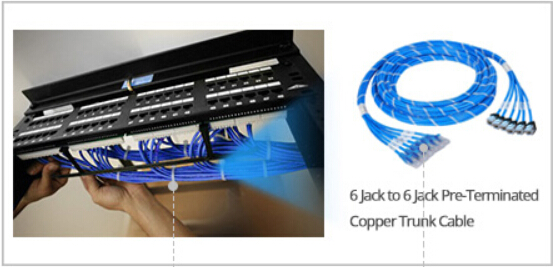
Figure 2 shows 6 Jack to 6 Jack Pre-terminated Copper Trunk Cable.
- Flexibility, Efficiency and Reliability
The Pre-terminated Cat 6 copper bundles can be supplied in any length up to 60m and both ends have an installed Cat 6A modular jack (UTP). The cable bundle is held together with Velcro wraps at meter intervals and is generally supplied with 6 cables & installed jacks in a bundle. Each end of the Pre-terminated can be easily installed into an unloaded 19 rack mount patch panel, floor distributor or wall outlet.
- Less labor intensive
Cat 6 Pre-terminated copper bundles require less work on site as no technical skills are needed when installing and connecting the cabling infrastructure. Therefore, this solution eliminates the need for technicians to be on site terminating cable, since the Pre-terminated cables can be easily installed by routing and then loading the Pre-terminated directly into a patch panel.
- Less Wastage
The installer in a lot of cases has to pay for his waste to be removed from site on many projects, especially if they include cable drums, more importantly the installer is purchasing a more accurate quantity of cable, they are buying by the meter and not by the drum, how many installers have their facilities cluttered up with odd lengths of cables in boxes hoping for a project that will use them up.
Pre-Terminated Cable Limitations
- Specialty cables must be planned for and ordered in advance
- Inflexible in field run situations
- Not feasible for retrofit and upgrade projects
Conclusion
Just as anything else, careful planning and product selection will be the key to a successful installation. You must consider resolution, distance, signal type or types, and physical layout when choosing a signal extension product. FS.COM Pre-terminated Cat 6 copper bundles offer rapid deployment coupled with guaranteed performance. Please feel free to contact us if you are interested.
Original Source : www.fiber-optic-solutions.com
Posted by: fernxu123 at
04:07 AM
| Comments (4)
| Add Comment
Post contains 681 words, total size 6 kb.
September 11, 2017
Fiber optic cable can be divided into several types. Usually we see single-mode and multimode fiber types available on the market. Multimode fibers are described by their core and cladding diameters. The diameter of the multi-mode fiber is either 50/125 µm or 62.5/125 µm. At present, there are four commonly used OM (multimode) fibers: OM1, OM2, OM3 and OM4. Each type of them has different characteristics.
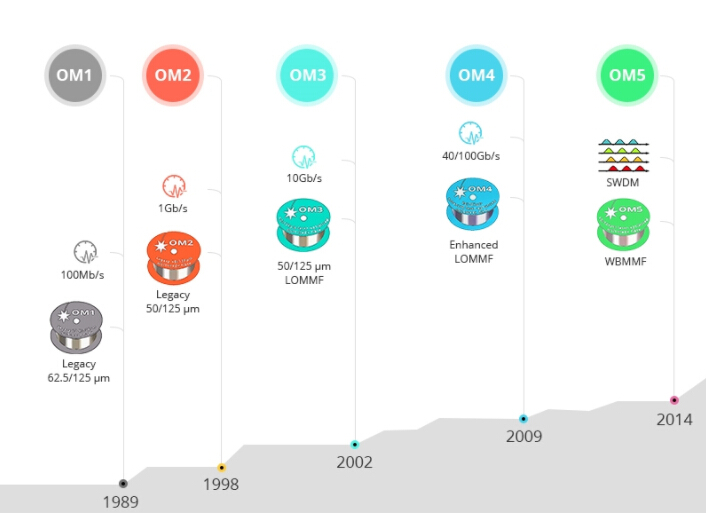
The picture above shows the development of OM multimode fibers. The Lime Green OM5 fibers are newly released and sure to be the mainstream transmission media in the near future. For more information about OM5 fibers, please turn to: OM5 Fiber Cable – Is It Worthwhile for 40G/100G SWDM4 Cabling Solution
OM Multimode Fiber Standard
Each "OM†has a minimum Modal Bandwidth (MBW) requirement. OM1, OM2, and OM3 are determined by the ISO 11801 standard, which is based on the modal bandwidth of the multi-mode fiber. In August of 2009, TIA/EIA approved and released 492AAAD, which defines the performance criteria for OM4. While they developed the original "OM†designations, IEC has not yet released an approved equivalent standard that will eventually be documented as fiber type A1a.3 in IEC 60793-2-10.

According to the above table,
- OM1 cable typically comes with an orange jacket and has a core size of 62.5 micrometers (µm). It can support 10 Gigabit Ethernet at lengths up 33 meters. It is most commonly used for 100 Megabit Ethernet applications
- OM2 also has a suggested jacket color of orange. Its core size is 50µm instead of 62.5µm. It supports 10 Gigabit Ethernet at lengths up to 82 meters but is more commonly used for 1 Gigabit Ethernet applications.
- OM3 has a suggested jacket color of aqua. Like OM2, its core size is 50µm. OM3 supports 10 Gigabit Ethernet at lengths up to 300 meters. Besides OM3 is able to support 40 Gigabit and 100 Gigabit Ethernet up to 100 meters. 10 Gigabit Ethernet is its most common use.
- OM4 also has a suggested jacket color of aqua. It is a further improvement to OM3. It also uses a 50µm core but it supports 10 Gigabit Ethernet at lengths up 550 meters and it supports 100 Gigabit Ethernet at lengths up to 150 meters.
OM1 Vs. OM2 Vs. OM3 Vs. OM4 Fiber
There are several differences between four kinds of multi-mode fiber, and we can see them clearly from the table below:
- Diameter: The core diameter of OM1 is 62.5 µm , however, core diameter of the OM2, OM3 and OM4 is 50 µm.
- Jacket Color: OM1 and OM2 MMF are generally defined by an orange jacket. OM3 and OM4 are usually defined with an aqua jacket.
- Optical Source: OM1 and OM2 commonly use LED light source. However, OM3 and OM4 usually use 850 nm VCSELs.
- Bandwidth: At 850 nm the minimal modal bandwidth of OM1 is 200MHz*km, of OM2 is 500MHz*km, of OM3 is 2000MHz*km, of OM4 is 4700MHz*km.
Why Are OM3 & OM4 Fiber Superior to OM1 & OM2?
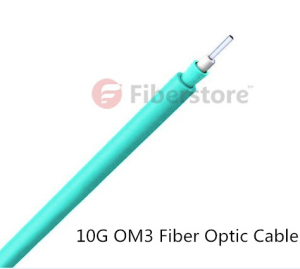 Both OM1 and OM2 work with LED based equipment that can send hundreds of modes of light down the cable, while OM3 and OM4 fiber are optimized for laser (eg. VCSEL) based equipment that uses fewer modes of light. LEDs can not be turned on/off fast enough to support higher bandwidth applications, while VCSELs are capable of modulation over 10 Gbit/s and are used in many high speed networks. For this reason, OM3 and OM4 are the multimode fibers included in the 40G and 100G Ethernet standard. Now OM1 and OM2 are usually used for 1G which are not suitable for today’s higher-speed networks. OM3 and OM4 are used for 10G mostly at present. But in the future, since OM3 and OM4 can support the 40G and 100G, which may make them the tendency.
Both OM1 and OM2 work with LED based equipment that can send hundreds of modes of light down the cable, while OM3 and OM4 fiber are optimized for laser (eg. VCSEL) based equipment that uses fewer modes of light. LEDs can not be turned on/off fast enough to support higher bandwidth applications, while VCSELs are capable of modulation over 10 Gbit/s and are used in many high speed networks. For this reason, OM3 and OM4 are the multimode fibers included in the 40G and 100G Ethernet standard. Now OM1 and OM2 are usually used for 1G which are not suitable for today’s higher-speed networks. OM3 and OM4 are used for 10G mostly at present. But in the future, since OM3 and OM4 can support the 40G and 100G, which may make them the tendency.
Original Source: www.fiber-optic-solutions.com/what-are-om1-om2-om3-and-om4.html
Posted by: fernxu123 at
03:44 AM
| Comments (2)
| Add Comment
Post contains 646 words, total size 6 kb.
August 25, 2017
For the data center or network upgrade, 40G network is a trending choice. Then where do you buy the 40G QSFP transceiver? Will you choose an OEM one or a third-party one? There are some differences between third-party 40G QSFP transceiver and OEM 40G QSFP transceiver, which will be shown below.
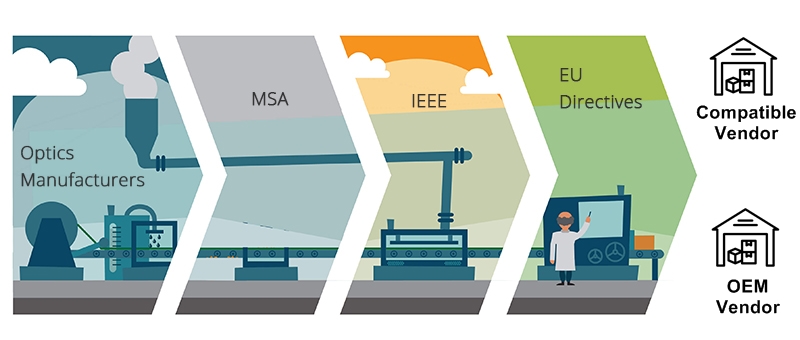
Features of OEM 40G QSFP Transceiver Modules
As we know, the OEM 40G QSFP transceiver from name brand like Cisco, Juniper and Brocade is widely used in data center and enterprise network. They all have some great features. The Cisco 40G QSFP transceiver offers a wide variety of high-density and low-power 40 Gigabit Ethernet connectivity options for data center, high-performance computing networks, enterprise core and distribution layers, and service provider applications. Here are some benefits of Cisco 40 Gbps transceiver:
- Hot-swappable input/output device that plugs into a 40 Gigabit Ethernet Cisco QSFP port
- Flexibility of interface choice (for different reach requirements and fiber types)
- Interoperable with other IEEE-compliant 40GBASE interfaces where applicable
- Certified and tested on Cisco QSFP 40G ports for superior performance, quality, and reliability
- High-speed electrical interface compliant to IEEE 802.3ba
- QSFP Form factor, 2-wire I2C communication interface and other low-speed electrical interface compliant to SFF 8436 and QSFP
The Brocade 40 Gbps transceiver supports highly reliable operations in data center and is optimized for Brocade switching platforms. It undergoes strict qualification and certification testing.
Why Choose 3rd 40G QSFP Optical Transceivers Over OEM?
40G QSFP transceiver from Cisco and Brocade is reliable and with high-quality, but why so many third-party 40 Gbps transceiver occurred on the market? The answer seems simple, the transceiver market need it. With high-speed development of the optical communication industry, the demand for 40G QSFP transceiver is increasing. The third-party 40G QSFP with good compatibility and high stability is the perfect choice for some customers. Here are some amazing advantages of the third-party 40 Gbps transceiver:
- Price advantage
Optics that you buy directly from name brand is expensive because it includes the costs of testing and validation, and the majority of what you pay for goes into their pocket as pure profit. While the third-party providers may not use the same testing procedures as the name brand, but most have nearly 100% success in compatibility. The third-party providers don’t mark up the 40G QSFP as much as the name brand, so they offer better price for the customer.
- Quality and Reliability
The third-party 40Gbps transceiver is reliable as the original one if you buy from a reliable optics provider. Usually, the reliable third-party provider will offer warranty and support after you buy from them, because they are highly focused and specialize in the optical transceiver market.
- More choice for 40G QSFP transceiver
The third-party optical transceiver is compatible for most name brand transceivers, so it will have more choice for your data center and enterprise networks.
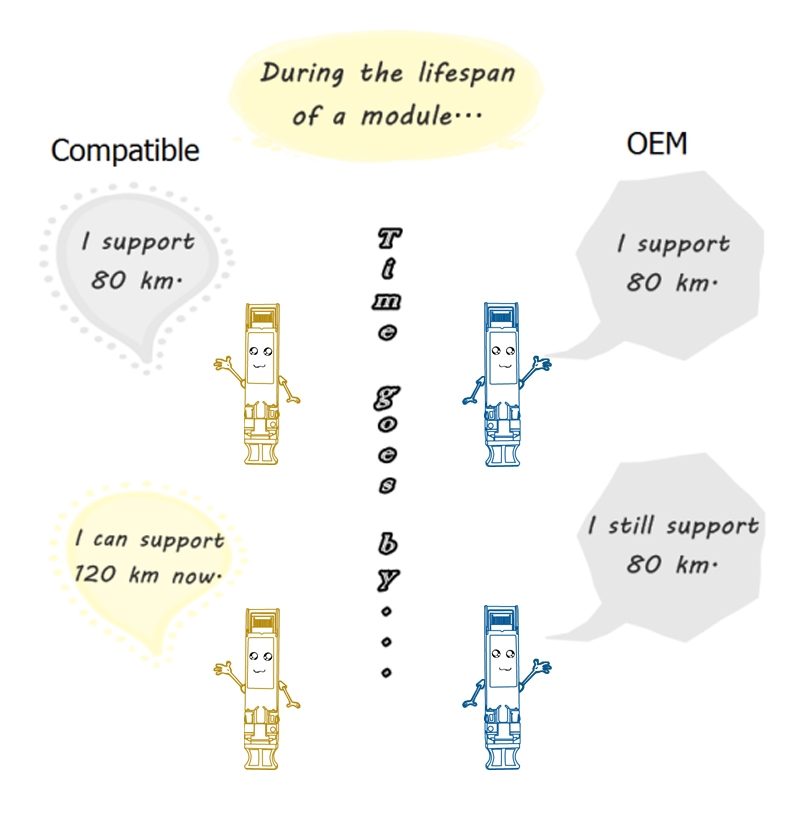
For the 40 Gbps transceiver, FS.COM provides various of compatible brands for you, Cisco, Genetic, Juniper Networks, Arista Networks, Brocode, HPE, Dell, Intel, IBM, etc. All have passed the compatibility testing.
Conclusion
After the comparison, will you choose the third-party 40G QSFP transceiver? Using third-party optics instead of name brand optics is a smart and innovative way to embrace changes in the dynamic networking and date center hardware markets. FS.COM will be you good choice with good compatibility, support offerings and great reputation.
Original Source: Why Third-party 40G QSFP+ Transceiver, Instead of OEM QSFP Module?
Posted by: fernxu123 at
09:13 AM
| Comments (3)
| Add Comment
Post contains 579 words, total size 6 kb.
August 11, 2017
Optical amplifier, with the introduction in 1990s, conquered the regenerator technology and opened doors to the WDM technology. It is mainly used to amplify an optical signal directly, without the need to first convert it to an electrical signal. There are many types of optical amplifiers, namely Raman amplifiers, erbium doped-fiber amplifiers (EDFAs), and semiconductor optical amplifier (SOA). This article will make a clearer introduction to SOA amplifier, and analyze its advantages and disadvantages.
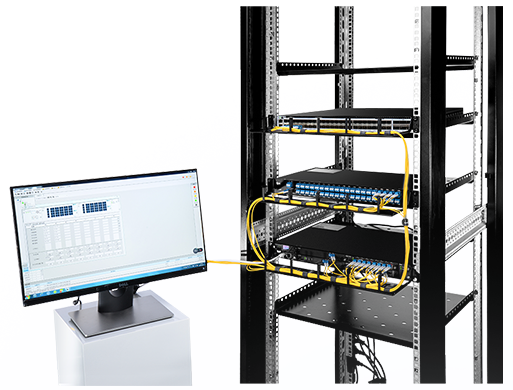
The Basics of Semiconductor Optical Amplifier (SOA)
SOA optical amplifiers use the semiconductor as the gain medium, which are designed to be used in general applications to increase optical launch power to compensate for loss of other optical devices. Semiconductor optical amplifiers are often adopted in telecommunication systems in the form of fiber-pigtailed components, operating at signal wavelengths between 0.85 µm and 1.6 µm and generating gains of up to 30 dB. Semiconductor optical amplifier, available in 1310nm, 1400nm, 1500nm, 1600nm wavelength, can be used with singlemode or polarization maintaining fiber input/output.
Key Points of SOA Amplifier
- 1310 nm, 1400 nm, 1550 nm and 1610 nm wavelength selectable
- High fiber-to-fiber gain of 20 dB
- Up to 16 dBm output
- 1 MHz with 10 ns pulse width (optional)
- PM Panda fiber input/output (optional)
- Similar to lasers, but with non-reflecting ends and broad wavelength emission
- Incoming optical signal stimulates emission of light at its own wavelength
- Process continues through cavity to amplify signal
Working principle of SOA amplifier
The basic working principle of a SOA is the same as a semiconductor laser but without feedback. SOAs amplify incident light through simulated emission. When the light traveling through the active region, it causes these electrons to lose energy in the form of photons and get back to the ground state. Those stimulated photons have the same wavelength as the optical signal, thus amplifying the optical signal.
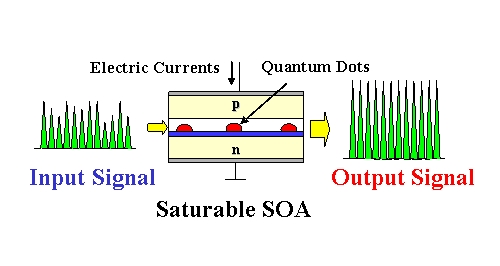
SOA Over EFDA in DWDM Networks
As the solution below, 120km Metro Networks by Using an SOA amplifier. You may wonder why not use EDFA in the above networks.

Theoretically, SOA optical amplifiers are not comparable with EDFA in the terms of performance. The noise figure of SOA optical amplifier is typically higher, the gain bandwidth can be similar, SOAs exhibit much stronger nonlinear distortions in the form of self-phase modulation and four-wave mixing. Yet, the semiconductor optical amplifier is of small size and electrical pumped, which is often less expensive than EDFA. Additionally, SOA can be run with a low power laser.
How to Choose SOA Optical Amplifier?
When selecting SOA amplifier, you have to check the every detailed parameter in the product data sheet. But, seriously, do you understand it? No, please read the following part.
The key parameters used to characterize a SOA amplifier are gain, gain bandwidth, saturation output power and noise.
Gain is the factor by which the input signal is amplified and is measured as the ratio of output power to input power (in dB). A higher gain results in higher output optical signal.
Gain bandwidth defines the range of bandwidth where the amplification functions. A wide gain bandwidth is desirable to amplify a wide range of signal wavelengths.
Saturation output power is the maximum output power attainable after amplification beyond which no amplification is reached. It is important that the SOA has a high power saturation level to remain in the linear working region and to have higher dynamic range.
Noise defines the undesired signal within the signal bandwidth which arises due to physical processing in the amplifier. A parameter called noise figure is used to measure the impact of noise which is typically around 5dB.
Conclusion
SOA amplifier is the economic, high-performance solution for long-hual WDM networks. SOA amplifier, due to its features, can be used in Booster and in-line amplification, optical network, general purpose test and measurement and fiber sensing. However, it also has its limit. In semiconductor optical amplifiers, electron-hole recombination occurs which will affect the performance of the whole line. FS offers EDFA, SOA, Raman optical amplifiers of excellent quality and price. For more detailed information, please feel free to contact us.
Original Source: Semiconductor Optical Amplifier
Posted by: fernxu123 at
06:39 AM
| Comments (3)
| Add Comment
Post contains 691 words, total size 7 kb.
July 17, 2017
The 10G SFP+ modules allow a wide variety of 10 Gigabit Ethernet connectivity options for enterprise, data center, and service provider transport applications. A single piece of hardware can accommodate a wide variety of cable and connection types, simply by substituting transceiver for the connector being used. Unfortunately, this also means that finding the right SFP+ transceiver for your application can sometimes be confusing and difficult, because many connection types exist: SFP-10G-SR, SFP-10G-LR, SFP-10G-LRM, SFP-10G-ER, SFP-10G-ZR, SFP-10G-T-S, CVR-XENPAK-SFP10G and CVR-X2-SFP10G. This article mainly talks about the difference between Cisco SFP-10G-SR and Cisco SFP-10G-LR.
The SFP+ is the enhanced small form-factor pluggable. It is also called SFP 10G to avoid confusion with the 1G version (SFP). It has the same shape as the SFP, but SFP+ can support data rates up to 10 Gbit/s. Specifically, it can support 8 Gbit/s on Fibre Channel and 10 Gbit/s on Gigabit Ethernet and optical transport network standard OTU2. As usual, it is a popular industry format because of the smallest 10G form factor for greatest density per chassis. The buyers for SFP+ are typically storage vendors and private data center operators. Other customers with large data center requirements may make the same decision and move forward with the SFP+.
Cisco SFP-10G-SR is designed for use with Cisco networking equipment. This transceiver module is the multimode 10G fiber optical transceiver with duplex LC connector, and it can support a link length of up to 26m on standard FDDI MMF and 300m link length when using 2000MHz KM MMF (OM3). In addition, it supports data transfer rates up to 10 Gbps with 850nm wavelength signaling. The hot-swappable supported feature has no need to power off the device when plugging into an Ethernet SFP+ port of a Cisco switch. It is manufactured to meet or exceed the specifications of the original Cisco unit, and to comply with MSA standards. It is electrical interface-compliant with SFF-8431 specification, and supports DDM.

The Cisco SFP-10G-LR is a 10GBase SFP+ Optical Transceiver with duplex LC connector. The 10GBase SFP+ optical transceiver supports distances up to 10 kilometers on standard single-mode fiber optic cables. It is also designed to operate with Cisco networking equipment. It also meets or exceeds the original specifications and complies with MSA standards. This 10GBase-LR transceiver is fully hot-pluggable, so you can install it without shutting down the network or rebooting your device. Furthermore, it supports data transfer rates up to 10 Gbps with 1310nm wavelength signaling. Its metallic housing allows low EMI. It also supports DDM, so you can monitor optical output power, optical input power, temperature, laser bias current and transceiver supply voltage. It is electrical interface-compliant with SFF-8431 specification, and supports up to 11.1 Gbps bi-directional communication.

SR stands for short reach, and LR stands for long reach. SR transceivers are almost always multimode, and optimized for high speeds over relatively short distances, while LR transceivers are designed for long-range communications, such as wiring buildings together on a large campus.

Table 1: Cisco SFP-10G-SR

Table 2: Cisco SFP-10G-LR
From these two tables, we can see the main differences are wavelenghth and cable type. SFP-10G-LR can reach up to 10km over single-mode fiber, which is designed for storage, IP network and LAN. At the same time, SFP-10G-SR is the original multimode optics specification, and it is still by far the most commonly used. As it uses a single, low cost solid state laser assembly, it is also the least expensive fiber optical modules available for a 10GbE platform. All in all, both SFP-10G-LR and SFP-10G-SR can ensure 10G transmission.
Except SFP-10G-LR and SFP-10G-SR, there are other similar Cisco compatible transceivers, including the: SFP-10G-LRM, SFP-10G-ER and SFP-10G-ZR. Each of these models is an SFP+ 10 Gigabit transceiver with digital optical monitoring capabilities. The table below outlines some of the key differences between these popular transceivers:

FS.COM provide compact, high quality and reliable interfaces for 10G Ethernet connections. I believe our 10G SFP+ transceiver is ideal for use in data centers, enterprise and service provider applications. Besides, we offer all brands and form factors of optical transceivers for all your networking needs. So you will find the most reliable, compatible and affordable way to expand your network. To learn more about FS.COM, or for a deeper consultation on your specific transceiver needs, just contact us directly or visit www.fs.com!
Posted by: fernxu123 at
11:43 AM
| Comments (8)
| Add Comment
Post contains 757 words, total size 7 kb.
July 13, 2017
When Cloud computing and web services continue to push the demand for bandwidth, new transmission medium must be developed to meet the requirements of end users. A new multimode optical fiber called OM5 fiber will allow to use the SWDM technology to transmit multiple wavelengths on one fiber. In this way, end users can obtain greater bandwidth and higher speeds. To help you use OM5 fiber to its greatest advantage, this article will introduce the basis of multimode fiber and OM5 fiber and highlight the key benefits of OM5 fiber. Consequently, you can find that OM5 is a new successful option for data centers.

Multimode fiber is a type of optical fiber that is designed to carry multiple light rays or modes simultaneously. It is mostly used for transmission over short distances in result of modal dispersion. Typically, the link length of MMF fiber cable is up to 600 meters (2000 feet). Besides, multimode fiber cable has a fairly large core diameter that enables multiple light modes to be transmitted. The core’s graded index profile is designed to slow down modes that have a shorter distance to transmit, so all modes arrive at the end of the fiber as close in time as possible. As a result, this process minimizes modal dispersion and maximizes bandwidth. In addition, multimode fiber optic patch cables have a large numerical aperture, the maximum angle at which a fiber can accept the light that will be transmitted through it. This allows them to work with relatively low-cost optical components and light sources such as LEDs and VCSELs.
OM5 is a wideband multimode fiber, which is a recently released fiber medium that is now recognized within TIA and IEC standards. OM5 fiber is a 50µm laser-optimized multimode fiber with extended bandwidth. It is designed to support SWDM applications in range of wavelengths from 850nm to 953nm for transmitting 40Gb/s and 100Gb/s, optimizing for reducing fiber counts for higher speeds. Specifically, OM5 fiber can reduce parallel fiber count by at least a factor of four to allow continued use of just two fibers (rather than eight) for transmitting 40 Gb/s(up to 400m) and 100 Gb/s(up to 150m).

To welcome the selection of the new fiber, the following is the key benefits of OM5 fiber:
- OM5 offers a wider range of wavelengths.
It supports wavelength from 850nm to 953nm for transmitting 40Gb/s and 100Gb/s, which is ready for next-generation wideband networks.
- OM5 will reduce costs.
OM5 fiber allows to use the SWDM technology to transmit multiple wavelengths on one fiber, increasing the bandwidth of a single fiber by a factor of at least four. Therefore, OM5 minimizes the number of fibers required to achieve greater speeds, and preserves the economic benefit of using multimode optical fiber.
- OM5 is required for higher speeds.
Through the SWDM technology, OM5 is provided the capability to increase transmission speeds.
- OM5 is ready for the future’s applications.
OM5 is backwards compatible to OM4 and OM3, and it can apply to future applications such as 40GBASE-SR, 100GBASE-SR, 200GBASE-SR, and 400GBASE-SR4, but also 128GFC and 256GFC.

For the increasing needs of today’s data centers, FS.COM meet the latest advances in technology, along with the demands of commercial and industrial applications. Currently, FS.COM introduces the OM5 multimode wideband fiber optic patch cables, these new fibers allow for continued economic benefit in deploying short reach optics using multimode optical fiber. What’s more, FS.COM offers the full performance range and has better optical and geometry specifications, which can allow for reduced connection / insertion loss and greater systems margin, which in turn enables longer reach, additional connections, and greater systems reliability. I believe that FS.COM is you best choice to select the OM5 fiber. Learn more about FS.COM OM5 fiber solutions, please visit www.fs.com.
Posted by: fernxu123 at
06:50 AM
| Comments (3)
| Add Comment
Post contains 647 words, total size 5 kb.
July 10, 2017
We know that fiber can carry more data over long distances than any other physical medium. That makes fiber a very precious material. And how to make the most use of your fiber plant becomes a question. So there comes Wavelength Division Multiplexing (WDM).

Why Should We Deploy WDM ?
WDM can multiply your fiber capacity by creating virtual fibers. The foundation of WDM lies in the ability to send different data types over fiber networks in the form of light. By allowing different light channels, each with a unique wavelength, to be sent simultaneously over an optical fiber network, a single virtual fiber network is created. Instead of using multiple fibers for each and every service, a single fiber can be shared for several services. In this way WDM increases the bandwidth and maximizes the usefulness of fiber. Since fiber rental or purchase accounts for a large share of networking costs, substantial costs can be saved through the application of WDM. Next I will introduce to you the basic four elements in the form of a WDM system.
The Core Technology of WDM System
Generally speaking, a WDM system consists of four elements, that are transceiver, multiplexer, patch cord and dark fiber. The following text will explain them to you respectively.
- Fiber Optic Transceivers. Optical transceivers are wavelength-specific lasers that convert data signals from SAN or WAN to optical signals that can be transmitted into the fiber. Each data stream is converted into a signal with a light wavelength that is an unique color. Due to the physical properties of light, channels cannot interfere with each other. Therefore, all WDM wavelengths are independent. Creating virtual fiber channels in this way can reduce the number of fibers required. It also allows new channels to be connected as needed, without disrupting the existing traffic services.
- Optical Multiplexers. The WDM multiplexer, sometimes referred to as the Mux, is the key to optimizing, or maximizing, the use of the fiber. The multiplexer is at the heart of the operation, gathering all the data streams together to be transported simultaneously over a single fiber. At the other end of the fiber the streams are demultiplexed and separated into different channels again.
- Patch cord. The transceiver transmits the high-speed data protocols on narrow band wavelengths while the multiplexer is at the heart of the operation. The patch cable is the glue that joins these two key elements together. LC fiber patch cables are popular, which connect the output of the transceiver to the input on the multiplexer.
- Dark fiber. A requisite for any WDM solution is access to a dark fiber network. The most common way of transporting optical traffic over an architecture is by using a fiber pair. One of the fibers is used for transmitting the data and the other is used for receiving the data. This allows the maximum amount of traffic to be transported. At times only a single fiber is available. Because different light colors travel on different wavelengths, a WDM system can be built regardless. One wavelength is used to send data and a second one to receive it.
Conclusion
WDM has revolutionized the cost of network transport. Thanks to WDM, fiber networks can carry multiple Terabits of data per second over thousands of kilometers with a low cost that is unimaginable less than a decade ago. At FS, we offer a comprehensive portfolio of WDM transmission modules to support the network applications of enterprise and service provider customers. For more details, please visit www.fs.com.
Posted by: fernxu123 at
07:58 AM
| Comments (2)
| Add Comment
Post contains 593 words, total size 5 kb.
June 12, 2017
Modern business have become increasingly digital for cloud and data center application, which means everything from sales and marketing to service and support, rely heavily on a fast and reliable network. In 2017, Gigabit Ethernet data rate is no longer adequate to support your business in the ever-developing digital world. Therefore, more and more people nowadays prefers to migrate to 10 Gigabit network. This blog will introduce some basic components of 10G network and how to layout 10GbE within your budget.
How Much Does It Cost?
Three expensive but dispensable elements of 10G network are 10G core switches, access switches with 10G uplinks, and 10G network interface cards for severs and storage devices.
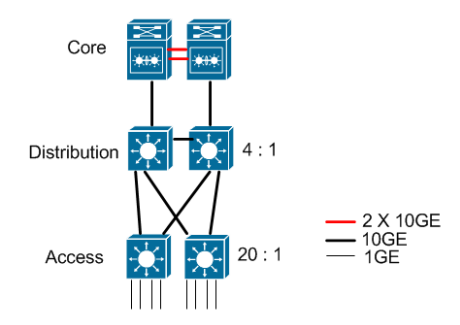
A 10G core switch might cost you $4000 10 years ago, but today, it heavily drops to under $150 per port. Take Cisco 550X and 350X series switches as the example, they offer a full series of 12, 16, 24, 48 10G ports for small and midsize enterprises nearly at $1,500. Obviously, the price can be pretty lower if you search around. For example, Ubiquiti Unifi and Edgeswitch series switches nearly at $200 are suitable for small businesses. FS S3800-48T4S with 48x 100/1000Base-T and 4x 10GE SFP+ is at $480.
For 10G access switches with 10G uplinks, FS S3800-24F4S, S3800-24T4S, S2800-24T4F provides 24 ports with 4 10G uplinks, starting from around $220.
A 10G network interface card (NIC) on severs or storage devices cost usually lower depending on the brand. The hot-selling Mellanox ConnectX series NICs are quite cheap on ebay and Amazon (for under $19).
10G Fiber Optic cabling Elements—10Gbase-T, DAC & SFP+ fiber optics?
When migrating from 1G to 10G, it is simple. Especially with 10GBase-T supported on your 10G switches, you use the same familiar RJ45 network cable to connect the 10G switch with your servers, storage and other switches, and they go up to the same 100 meters as in the Gigabit network. Just make sure you pick up a Cat6a RJ45 network cable instead of the cat5e or cat6a cables. 1m cat6a cables at FS.COM is $3.4. 10GBase-T technology is becoming more popular in network switches and servers because of its lower cost and ease of use. Besides the cat6a/cat7 Ethernet cables, you can also select SFP+ 10GBASE-T modules with 2.5W power consumption and a maximum distance of 30m. SFP+ 10GBASE-T offered at FS.COM is nearly $380.
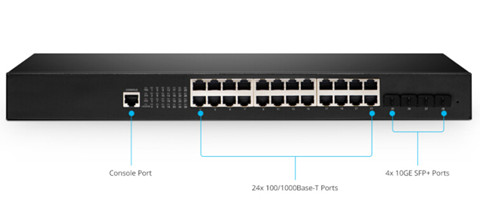
FS S3800-24F4S (seen in the above image), S3800-24T4S and S2800-24T4F also support 10G SFP+. You are recommended to use SFP+ ports if you have existing devices that come with 10G SFP+ port or you need a 10G connection to other switches that are more than 100 meters away.
For servers or storage devices with 10G SFP+ port, the most cost-efficient way to connect is to use SFP 10G DAC (direct attach cable). These are basically copper cables with SFP+ connector on both sides, and they come in limited length of 1m, 3m and 5m. 0.5m 10G DAC cables at FS.COM is $9.5.
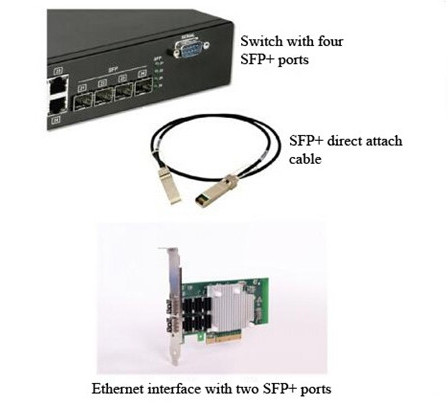
For switches that are more than 100 meters away, you will need a pair of SFP+ modules and the matching fiber cable between them. Depending on the length required, you can use multimode SFP+ and fiber to reach 400 meters and single-mode SFP+ and single-mode fiber optic cables to reach 10 km. For the reliable 10G devices like SFP+ and fiber optic cables, you can visit FS.COM.
How to Ensure a Smooth 10G Upgrading
You don’t need to rush your whole network to 10GbE in one step. Just start from the core switches that you use to connect all your access switches together and connect your servers and storage devices. Think about how many ports you need and if redundancy is a concern for you. Having two core switches stacked together to provide redundancy and also extra performance is a good design for a solid network foundation.
After upgrading your core switches to 10G, it is time to migrate your key access switches and servers to 10G. You will see immediate performance gain in the most critical parts of your network. The rest of the network can stay as they are for the moment, because 10GBase-T ports are backward compatible with Gigabit links, and 10G SFP+ cage can also work with 1G SFP modules. You can upgrade the rest of your network to 10G whenever you’re ready or in multiple phases if you wish.
Conclusion
I bet you must have a good understanding of what’s between the 10 Gigabit high-performance network. The technology is not complicated, especially with FS 10G switches, Cat6a cables, SFP+ transceivers and SFP+ DAC cables. We will help you build a user-friendly and cost-efficient 10G networks. For more information on FS 10G series switches, please contact us directly.
Posted by: fernxu123 at
08:45 AM
| Comments (3)
| Add Comment
Post contains 796 words, total size 6 kb.
May 27, 2017
25G Ethernet was treated as the "new†10GbE technology once it came out in 2014. Similar to 10G Ethernet that was based on 1 x 10Gbps lane scheme, 25GbE physical interface delivers 1 x 25Gbps more data. 25GbE technology with one single lane obviously improves the port density and cost requirement. 25GbE network supports several 25Gbps capable form factors, such as CFP, CFP2, CFP4, SFP28 (1×25 Gbps) and QSFP28 transceiver (4×25 Gbps), which is also used for 100GbE. Of which 25G SFP28 SFP-25G-SR and SFP-25G-LR are two popular optical transceiver modules on the market, the former supporting up to 100m link length while the latter allows a maximum transmission distance of 10 km. This article will make a brief comparison between 25G SFP-25G-SR & SFP-25G-LR optical transceiver modules, and analyze the utilization in 25G to 100G upgrading.
SFP-25G-SR Overview
SFP-25G-SR is 850nm VCSEL 25Gigabit SFP28 transceiver designed to transmit and receive optical data over 50μm duplex LC multimode optical fiber (MMF). 25G SFP28 SR optics can support up to 70m over parallel OM3 Multimode fiber and 100m over parallel OM4 cable. This 25G SFP transceiver is equipped with Digital Optical Monitoring (DOM) function and can be delivered with different temperature ranges, allowing access to real-time operating parameters.
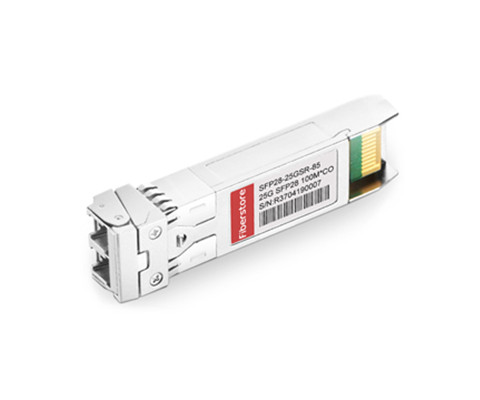
SFP28 SR MMF transceiver optics is comply with current specifications of IEEE 802.3, SFF-8472, SFF-8402, SFF-8432 and SFF-8431. It’s suitable for use with 25GbE Ethernet switches, routers, network interface cards (NICs) and storage networking equipment. The SFP28 SR optics offers the most power efficient way to meet the growing needs of the next-generation data center networking environment.
SFP-25G-LR Outline
SFP28-25G-LR is the SFP28 LR optical transceiver module for 25 Gigabit Ethernet long-reach application. This SFP28 LR optics module features a highly reliable 1310nm DFB transmitter and PIN photo-detector into duplex LC optical connector, providing links up to 10km over single mode fiber (SMF).
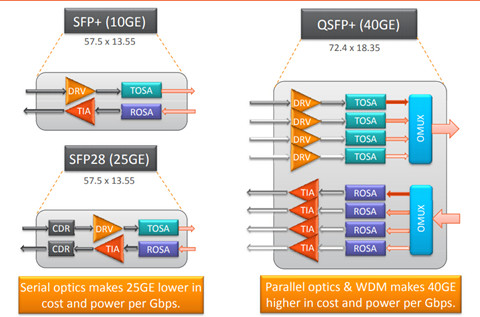
The SFP28 LR SMF transceiver optics is comply with current specifications of IEEE 802.3, SFF-8472, SFF-8402, SFF-8432 and SFF-8431. It’s suitable for use with 25GbE Ethernet switches, routers, network interface cards (NICs) and storage networking equipment. The SFP28 LR optics offers the most power efficient way to meet the growing needs of the next-generation data center networking environment. The above image displays the vivid comparison between 25G SFP28 LR optics and 40G QSFP+ LR4 modules.
SFP-25G-SR & SFP-25G-LR Used in 25G to 100G Data Center Migration
Energy saving and cost are the two important considerations for data center applications. Nowadays 10G Ethernet speed can not meet the demands of increased sever performance, and the 100G relevant devices are too expensive, the appearance of 25G Ethernet standards just made up for the deficiency of them. Compared with 40GbE connectivity, 25GbE requires just one lane (four with 40GbE) but offers superior switch port density, lower costs and power requirements. Therefore, 25GE is good choice as next step after 10GE for SMF and MMF transceivers.
SFP-25G-SR and SFP-25G-LR are the single-channel, pluggable, fiber-optic SFP28 modules for 25 Gigabit Ethernet and Infiniband EDR applications, with low power dissipation 1W.
- 100G to 25G MMF Short-reach Connection
As the following image shows, MTP12 to 4xLC MMF fiber breakout cables are needed to connect between 100G QSFP-100G-SR4 and 25G SFP-25G-SR. This connection types can support up to 100m.
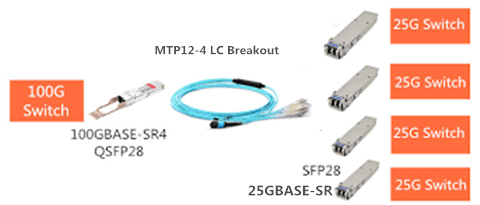
- 100G to 25G SMF Long-reach Connection
As the table 2 shows, SFP28 SFP-25G-LR connects with QSFP28 QSFP-100G-PSM4 over the MTP12 to 4xLC SMF fiber breakout cable. The whole setup can support up to 500m over parallel single mode fiber.

Conclusion
With the rapid development of Internet, cloud computing and big data in recent years, the construction of IT infrastructure data center has been accelerated. A new round of updating is underway for the Ethernet including 25GbE, 40GbE, 50GbE, of them 25G Ethernet is favored. 25G SFP-25G-SR and SFP-25G-LR SFP28 optical transceivers provide smooth and cost-effective solution to 100G networks. FS.COM offers several 25G SFP28 optics to meet your demand. If you are interested, you can have a look at it.
Posted by: fernxu123 at
02:54 AM
| Comments (2)
| Add Comment
Post contains 672 words, total size 6 kb.
May 12, 2017
With the price of 100G optics cutting down, 2017 witnesses the great expansion of `100G hardware market. QSFP28 and CFP 100G optical transceivers are becoming popular among customers. Not only Cisco, HPE, Brocade, and Huawei, but the third party vendors like FS.COM offer 100G devices including the 100G switches, MTP/MPO cables, QSFP28, CFP/CFP2/CFP4 and so on. In this blog, I will compare 100G QSFP28 SR4 with CFP SR10 modules, and analyze the electrical and optical diagram.
CFP 100GBASE-SR10 Module Outlook
CFP 100GBASE-SR10 is a MSA specified 100G C-form factor supporting link lengths of 100 m/150 m over laser-optimized OM3/OM4 cable, respectively. It is mainly used in 10 x 10 Gigabit Ethernet mode along with MTP Harness cables for connectivity to 10 10GBASE-SR optical interfaces. It usually enables high-bandwidth 100Gbps links over 24-fiber MPO/MTP ribbon cables.
100G QSFP28 100GBASE-SR4 Outlook
QSFP28 100GBASE-SR4 module is a parallel 100G optics designed with optical/electrical connection and digital diagnostic interface. It offers 4 independent transmit and receive channels, each capable of 25Gbps operation for an aggregated data rate of 100Gbps for 100m on 12-fiber MPO/MTP OM4 fiber cable. Figure 1 shows the CFP SR10 (left) and QSFP28 modules (right).
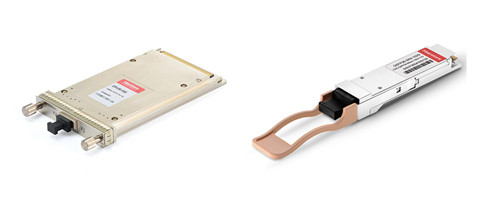
The QSFP28 SR4 transceiver (such as Cisco 100G-QSFP28-SR4) is compatible with 100G QSFP 100GBASE-SR4 standards that meets IEEE 802.3 and MSA requirements with power dissipation well under 3.5W. It supports both 100GBASE-SR4 as well as 4x25G breakout, 100G QSFP28 to QSFP28 DAC and 100G QSFP28 SR4 to 4SFP28 break-out cables.
Comparison Between CFP 100GBASE-SR10 and 100G QSFP28 100GBASE-SR4
- Size Comparison
CFP module is the old generation 100G transceivers. It is designed after SFP modules, but quite larger to support 100Gbps in 10 x 10Gbps lanes. QSFP28 is the newly released 100G form factor, which further increase port density and reduce footprint & power consumption. QSFP28 100GBASE-SR4 has the same form factor as the 40G QSFP optics, supporting 4x25Gbps mode.
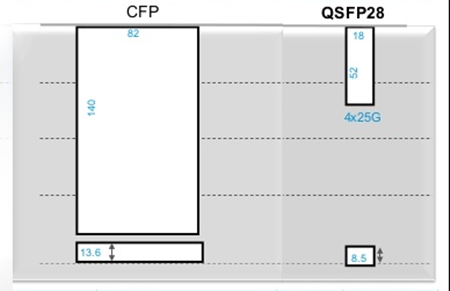
The above image shows the size comparison between CFP 100GBASE-SR10 and 100GBASE SR4 QSFP transceiver. Obviously, QSFP28 is much smaller than CFP 100G modules, which just in time explains the reason that QSFP28 optics is more popular than CFP transceivers.
- Working Principle
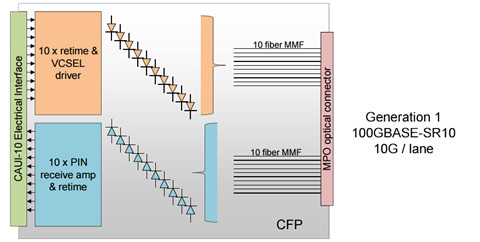

100GBASE-SR4 supports higher speed per channel (25Gbps) than 100GBASE-SR10 (10Gbps), so that QSFP28 can reduce port density with compact footprint.
- Terminating Cables—12F Vs. 24F MTP/MPO MMF
Both CFP 100GBASE-SR10 and 100G QSFP28 100GBASE-SR4 terminates with MTP/MPO OM3/OM4 cables for 100G transmission. However, QSFP28 100GBASE-SR4 modules uses a 12 fibers MPO/MTP multimode cable for connectivity (4 Tx and 4 Rx, each lane providing 25 Gbps of throughput) while CFP 100GBASE-SR10 optics use a 2×12-fiber or 24-fiber strand MPO/MTP multimode cable for connectivity (10 Tx and 10 Rx, each lane providing 10 Gbps of throughput).
CFP 100GBASE-SR10, compared with QSFP28 SR4 optics uses two 12-fiber or one 24-fiber MPO/MTP cable. It is not a cost-effective solution in terms of the cable management.
Conclusion
100GBASE-SR10 CFP and 100GBASE-SR4 QSFP28 are the 100G multimode optics. QSFP28 SR4 transceivers, like 40GBASE-SR4, use a 12 fiber MPO cable with 4 strands for transmit and 4 for receive. While CFP 100GBase-SR10 optics uses a 24 strand MPO cable: 10 strands for transmit and 10 strands for receive. From the above article, we know that 100GBase-SR4 QSFP28 is more cost-effective than 100GBase-SR10 CFP in port density and cable management. FS.COM QSFP28 SR4 is offered at $269 with free shipping to USA, Mexico and Australia. Our reliable 100G CFP modules are also with high quality and low price. If you have any interest, don’t forget to contact us.
Posted by: fernxu123 at
02:37 AM
| Comments (1)
| Add Comment
Post contains 607 words, total size 6 kb.
May 09, 2017
Today’s technology presents unprecedented migration incorporating a wide range of application requirements such as database, transaction processing, data warehousing, integrated audio/video, real-time computing, and collaborative projects. Fibre Channel and Gigabit Ethernet, both are the ideal solutions for IT professionals who need reliable, cost-effective information storage and delivery at fast speeds. Fibre Channel is available in 1G/2G/4G/8G/16G FC and 10GFCoE, 40GFCoE and 100GFCoE nowadays. Gigabit Ethernet is the reigning network for data center and server room. The battle between Fibre Channel and Ethernet is complicated. However, this article will help you solve it out by comparing 10G SFP+ Fibre Channel transceiver modules and 10G Ethernet SFP+ modules.
Any time we’re transmitting or storing data, we encode it in some form or another. Then we need to understand the encoding mechanisms of Ethernet and FC.
1, 2, 4, and 8 Gb Fibre Channel all use 8b/10b encoding. Meaning, 8 bits of data gets encoded into 10 bits of transmitted information, the two bits are used for data integrity. For example, Original 1Gb FC is actually 1.0625Gb/s, and each generation has kept this standard and multiplied it. 8Gb FC would be 8×1.0625, or actual bandwidth of 8.5Gb/s. 8.5*.80 = 6.8. 6.8Gb of usable bandwidth on an 8Gb FC link.
10GE (and 10G FC, for that matter) uses 64b/66b encoding. For a 10Gb link using 64b/66b encoding, that leaves 96.96% of the bandwidth for user data, or 9.7Gb/s.
10G SFP+ Fibre Channel (FC) transceiver, as the name implies, is the 10G optical transceivers used for Fibre Channel applications. 10G FC SFP+ module has the same footprint as SFP form factor and is compliant with MSA SFF-8431. 10G SFP+ Fibre Channel transceivers uses the either the 850nm VCSEL as the transmitter fro multimode fiber or 1310nm/1550nm laser as the transmitters for single-mode fibers in SONET OC-192 /SDH, 10GBASE-SW, 10GBASE-LW, 10GBASE-EW, and 10GBASE-ZW applications.
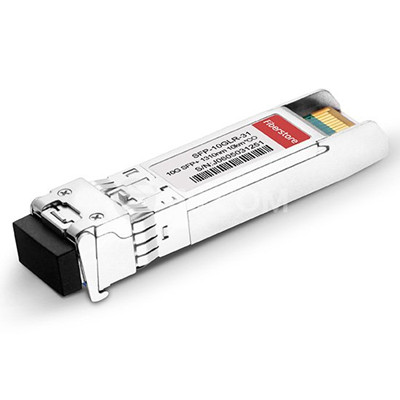
Cisco DS-SFP-FC10G-LW, seen in the above image, is the long-range single-mode 10G SFP+ FC optical module for a link length of 10km over 1310nm wavelength. 10GFC is backward compatible with previous generation 8G/4G/2GFC and will auto-negotiate down to the fastest speed supported by both ports. This allows 10GFC devices and switches to be seamlessly integrated into expansion segments of existing FC networks without a forklift upgrade.
SFP+ 10G modules is the optical transceiver for serial optical communication applications at 10Gbps. Unlike the SFP+ FC transceivers, 10GBASE SFP+ Ethernet modules can use either copper or fiber cabling. SFP+ 10GBASE-T optical transceiver supports Cat6 RJ45 copper cables for a link length of 30m. 10GBASE SFP+ Ethernet modules are available in several 10 Gigabit Ethernet standards like 10GBASE-SR Ethernet, 10GBASE-LR, 10GBASE-LRM, 10GBASE-ER, 10GBASE-ZR, and 10GBASE-T.
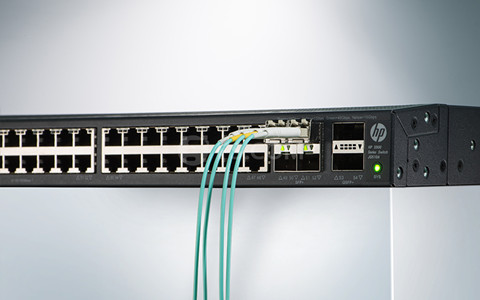 Cisco SFP-10G-LR is the 10km Cisco 10GBASE-LR SFP+ module that uses 1310nm as the transmitter type over single-mode fiber cables. 10GBASE-LR SFP+ modules cannot be auto-negotiate with 1000BASE SFP transceivers, but for most switches, SFP+ ports can support 1G SFP modules for 1Gbps data rate.
Cisco SFP-10G-LR is the 10km Cisco 10GBASE-LR SFP+ module that uses 1310nm as the transmitter type over single-mode fiber cables. 10GBASE-LR SFP+ modules cannot be auto-negotiate with 1000BASE SFP transceivers, but for most switches, SFP+ ports can support 1G SFP modules for 1Gbps data rate.
From the previous description, we can easily draw a conclusion that 10G Fiber Channel SFP+ and 10G Ethernet SFP+ share several specification in common.
- Footprint
- Performance
Except the application, 10G Fiber Channel SFP+ SW module and 10Gb SR SFP+ transceivers have the very similar functions with each other. For the exact information, please see the following table.

- Application
10G Fiber Channel SFP+ is used in 10G Fibre Channel, yet 10G Ethernet SFP+ is utilized in 10G Ethernet networks.
Without denying, Ethernet is the dominating network for every data center and server room. The "old†Ethernet network—1Gb/s and 10Gb/s speeds relied heavily on TCP to deliver data, which was reliable but somewhat unpredictable. However, today’s Ethernet runs at 25, 40, 50, or 100Gb/s speeds, is no longer dependent on TCP alone. It also supports RDMA connections which lower latency and frees up CPU cycles to run applications. 100Gb/s technology is quite matured in 2017 and there are many relevant devices available on the market, such as CFP/QSFP28 optical transceivers, 100G switches and network interface cards, 24 fiber MTP cables, etc.
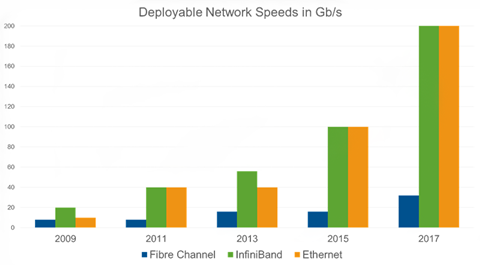
Meanwhile, FC is still transitioning to 16/32 Gb/s technology (32Gb/s is not mature), which is quite slower than what Ethernet was supporting several years ago. For 32Gb/s FC network, it still supports only block storage traffic. Other storage (and other non-storage) traffic will require an Ethernet network anyway.
If we look at what is coming in 2017, the battle will not be 10/40/100GbE Vs. 8/10/16/32Gb FC. Almost everyone would agree that it would be nice to have a single network for all traffic, and very few users want a new protocol and the challenges of changing the way that they do things.
FC or Ethernet, which is best for storage? 10Gb FC SFP+ has the same usable bandwidth as the 10Gb Ethernet SFP+, and without the overhead of FCoE, but you don’t get the consolidation benefits of using the same physical link for your storage and traditional Ethernet traffic. FS.COM offers reliable 10G SFP+ transceivers in Ethernet, FC, BiDi, CWDM/DWDM applications. If you are interested in our products, please contact us directly.
Posted by: fernxu123 at
08:50 AM
| Comments (1)
| Add Comment
Post contains 890 words, total size 8 kb.
April 28, 2017
The C form-factor pluggable (CFP) is specified by a multi-source agreement (MSA) among many manufacturers for the transmission of high-speed digital signals. The CFP transceiver can both support 100 Gbit/s or OTU4, and 40Gbit/s OTU3 signals. The 40G and 100G CFP transceivers are hot-swappable input/output devices that can be plugged into the 40-Gigabit and 100-Gigabit Ethernet module ports. CFP-40G-LR4 has the same footprint as CFP-100G-LR4, and both of them terminate with duplex SC fiber connectors. Except that they support different transmission distance, what are the detailed information about them?
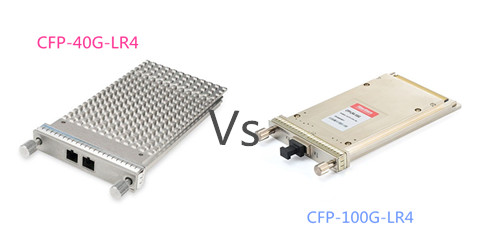
40G CFP-40G-LR4
The Cisco CFP form factor can also operate over 40GbE, supporting both single-mode and multimode fiber and a variety of data rates, protocols, and link lengths, including all the physical media-dependent (PMD) interfaces contained in the IEEE 802.3ba Task Force. 40GBASE CFP optical transceiver module supports 40GBASE Ethernet and OTU3 standards, which can be used in core and distribution layers of data center enterprises, and service provider networks. Cisco releases CFP-40G-LR4, CFP-40G-SR4, and CFP-40G-FR modules.
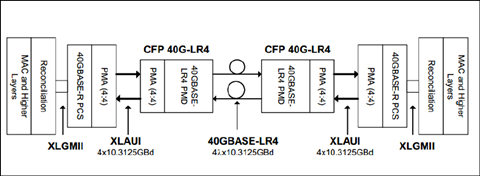
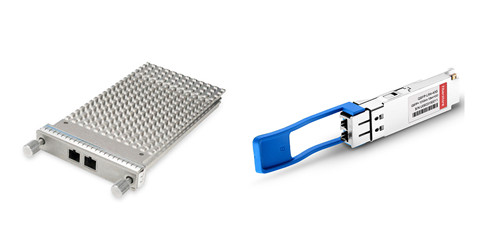
CFP-40G-LR4, similar with QSFP-40G-LR4, is compatible with IEEE 40GBASE-LR4 standard and operates link length of up to 10km over standard single-mode fiber(OS2). However, CFP-40G-LR4 uses SC duplex connectors with a larger form factor, while QSFP-40G-LR4 utilizes LC duplex connector with a compact footprint ( as shown in the above image).
CFP-100G-LR4
100G CFP modules use 10 x 10 Gbit/s lanes in each direction (RX, TX), the optical connection can support both 10 x 10 Gbit/s and 4 x 25 Gbit/s variants of 100 Gbit/s interconnects (typically referred to 100GBASE-SR10 in 100 m reach respectively and 100GBASE-LR4 in 10 km reach.)
Cisco 100GBASE-LR4 CFP is the 100G CFP type that was designed for long-reach 100GbE applications. CFP-100G-LR4 supports a link length of 10 km on standard SMF with duplex SC connectors. It is running at four optical wavelengths (1295.56 nm, 1300.05 nm, 1304.59 nm, 1309.14 nm) and muxing/demuxing of these wavelengths happening inside CFP module.
Comparison Between CFP-40G-LR4 and CFP-100G-LR4
CFP-40G-LR4 and CFP-100G-LR4 share many points in common, such as the wavelength, fiber type, max distance, fiber optic connector and DOM support. Nevertheless, CFP-40G-LR4 is used in 40GbE network, and CFP-100G-LR4 is in 100GbE.

To further understand the difference between CFP-40G-LR4 and CFP-100G-LR4, let’s have a look at the CFP architecture. According to the below image, the whole CFP diagram is composed of two parts—equipment Line card ASC or FPGA, line card interface and optical line interface. There are several "M-Lines†with 10Gbps speed between equipment line card and electrical interface.
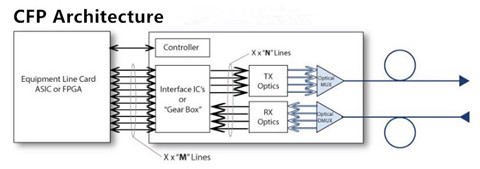
If CFP is working 100GBase-LR4 mode, then it has 10 x 10Gbps M-Lines. As to 40GBase-LR4, it uses 4 x 10Gbps M-Lines. The "gear box†in the image is electrical 10:4 mux/demux module aggregating up to 10 M-Line interfaces in maximum 4 N-Line interfaces. Each N-Line is 25Gbps for 100GBase-LR4 and 10Gbps for 40GBase-LR4. So you may clearly understand the difference between CFP-40G-LR4 and CFP-100G-LR4.
Conclusion
The CFP MSA transceiver module defines hot-pluggable optical transceiver form factors to enable 40GbE and 100GbE applications. CFP-40G-LR4 and CFP-100G-LR4 are the CFP LR4 optics that are compatible with 40GBASE-LR4 and 100GBASE-LR4 standards. Other than the CFP form factor modules, pluggable CFP, CFP2 and CFP4 transceivers support the ultra-high bandwidth requirements of data communications and telecommunication networks that form the backbone of the internet. FS.COM offers a whole sale of CFP/CFP2/CFP4 optical transceivers that available in several standards. Please feel free to contact us if you need anything.
Posted by: fernxu123 at
03:13 AM
| Comments (3)
| Add Comment
Post contains 575 words, total size 6 kb.
April 21, 2017
100G QSFP28 and CFP optical transceivers as the main transmission media of 100G network, dominate 100G hardware market. CPAK, launched right after CFP2 100G modules, is the Cisco proprietary form factor. Since its certification, CPAk was considered as the alternative of CFP form factor modules. Today's article will describe CPAK 100G module in detail and compare it with other 100G modules such as CFP, CFP2, CFP4 and QSFP28 modules.
Designed as a smaller, low-cost alternative to CFP transceiver, CPAK 100GBASE optical module is not popular on the 100G market nowadays. CPAK module is also the first 100G optical transceiver that uses CMOS Photonics technology. This type of 100GBASE module can work in the following Cisco networking equipment—ASR 9000 Series Router; CRS-X Carrier Routing System; NCS 2000, 4000, and 6000 Series Routers; the Nexus 7000 and 7700 Series Switches, and the Cisco ONS Transport Platform.
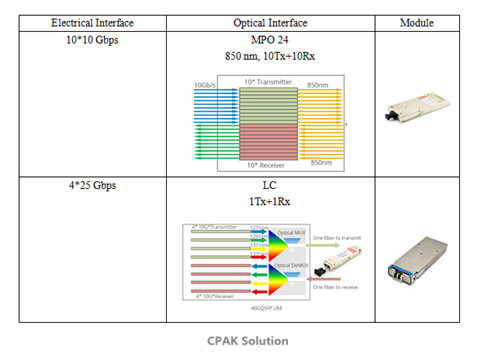
CPAK optical transceiver incorporates IEEE standard interfaces available in several different standards: 100GBASE-SR10, 100GBASE-ER4L, 100GBASE-LR4, 10x10G-ERL, 10x10GBASE-LR, etc. CPAK transceivers can support 10X10Gbps and 4X25Gbps mode for an aggregate of 100Gbps data rate (seen in the above image). It can operate high-density 10G breakout with MPO-24 cables, CPAK-100G-SR10 is operating in this type, which is also backward compatible with 10GBASE-SR. CPAK LR4 module is compatible with other 100GBASE-LR4 compliant modules such as CFP to support high-bandwidth 100Gb optical links over standard single-mode fiber terminated with SC connectors.
The main features of CPAK modules are backward compatibility, smaller form factor and energy efficiency.
As noted before, CPAK was released right after CFP modules. Although CFP is the pioneer in 100G optics, but its big size can not meet the demands of high-density data center. Therefore, CFP2 and CFP4 with more compact sizes are developed. When comparing CPAK with CFP modules, CPAK transceivers are less than one third the size of CFP modules, and dissipate less than one third the power. In a comparison with CFP2 modules, CPAK optical transceivers are 20% smaller and consume 40% less power. In other word, if you use CPAK other than CFP2 modules in your data center switches, it can offer 20% greater port density and front-panel bandwidth.
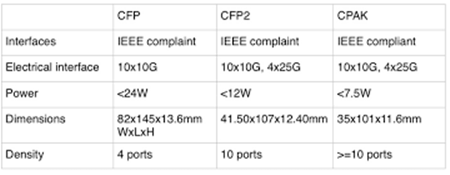
In short, CPAK optical module has smaller footprint than CXP, CFP and CFP2, but bigger than CFP4 and QSFP28 optics. Besides, CPAK 100GBASE-LR4 consumes less than 5.5W, which is less than CFP LR4 (24W), CFP2 LR4 (12W), CFP4 (9W) and CXP LR4 optics (6W) but a little higher than QSFP28 (3.5W). CPAK represents a significant advancement in optical networking, providing dramatic space and power efficiency.
QSFP28 optical transceiver, due to its smallest form factor and lowest power consumption, is regarded as the most promising 100G optical module. In terms of the form factor, QSFP28 is more compact then CPAk modules. As to the power consumption, Cisco CPAK 100GBASE-LR4 module supports link lengths of up to 10 km over standard single-mode fiber with SC connector with a nominal power consumption of less than 5.5W. QSFP28 100GBASE-LR4 supports up to 10km and consumes nearly 3.5W.
QSFP28 transceiver is designed for 100G speeds and using the 4×25 wiring specification. 100G QSFP28 SR4 is designed for short-haul transmission and QSFP28 LR4 is designed for long-haul transmission.
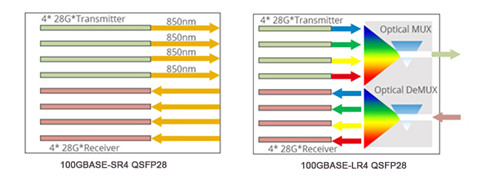
In 2017, 100G technology and relevant optical transceivers gradually become matured. 100G optics like CXP, CFP/CFP2/CFP4, 100G QSFP28 in different standards offers a huge selection for customers. CPAK module was launched just days after the certification of CFP2 optics. It is popular for the smaller footprint and energy economy. However, when competing with open source MSA compatible 100G products (CFP/CFP2/CFP4 and QSFP2![]() , CPAK is not the ideal one for 100G high-density connectivity. However, many third party optical solution vendors like FS.COM announce to help market to cut down this pricing and save budgets for customers. FS.COM will release this cable in the near future, if you are interested, please contact us.
, CPAK is not the ideal one for 100G high-density connectivity. However, many third party optical solution vendors like FS.COM announce to help market to cut down this pricing and save budgets for customers. FS.COM will release this cable in the near future, if you are interested, please contact us.
Posted by: fernxu123 at
08:04 AM
| No Comments
| Add Comment
Post contains 660 words, total size 6 kb.
April 07, 2017
Cisco SFP module, compatible with 1000BASE Gigabit Ethernet standard is a hot-swappable input/output device that can plug into a Gigabit Ethernet slot of Cisco switches and routers. Cisco, as a telecom giant supplies a whole series of fiber optic transceiver modules available in 1000BASE-T, 10/100/1000BASE-T, 1000BASE-SX, 1000BASE-LX, 1000BASE-EX, 1000BASE-ZX standards. It is truly dizzying to choose from a whole array of Cisco SFP transceivers, and each often has only minor differences between them. Thus, to help customers choose the suitable Cisco SFP modules, this article will clearly introduce several Cisco GLC modules.
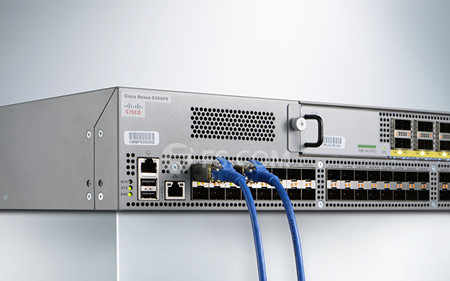
Figure 1 shows Cisco SFP plugging into the Cisco Nexus 9396 switches.
GLC-T
GLC-T is 1000BASE-T Cisco SFP copper 1g module, compliant to IEEE 802.3, operates over Cat5 copper wire for a distance of 100m. Cisco GLC-T fiber transceivers provide 1Gbps data transfer for full duplex Gigabit Ethernet connectivity.
GLC-TE
Similar with GLC-T SFP modules, GLC-TE provides a link length of 100m over Cat5 copper wires. The only difference between these two SFP modules lies in the operating temperature range. GLC-T SFP is commercial temperature range (COM) from 0 to 70°C (32 to 158°F), while GLC-TE is Extended temperature range (EXT) from -5 to 85°C (23 to 185°F).
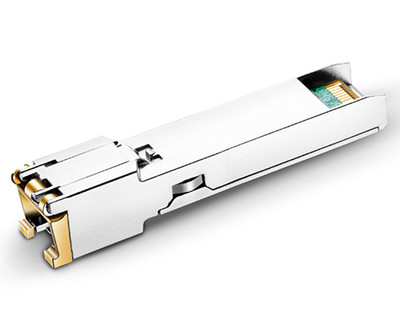
Figure 2 displays GLC-TE SFP module with RJ45 connector.
GLC-SX-MMD
GLC-SX-MMD resembles with GLC-SX-MM module. Both are the Cisco 1000BASE-SX SFP modules operating at the wavelength of 850nm. When connecting with OM2 multimode fibers, this optical transceivers can support up to 550m. However, GLC-SX-MMD allows data rate of 1000Mbps with digital optical monitoring (DOM) support, which performs transceiver monitoring and troubleshooting operation.
SFP-GE-S
SFP-GE-S is compliant with 1000BASE-SX standard. It operates over multimode fibers with a wavelength of 850nm at 550m. Unlike GLC-SX-MM, SFP-GE-S support DOM performance and extended operating temperature range.
GLC-LH-SMD
Compliant with 1000BASE-LX/LH standard, Cisco GLC-LH-SMD can support a large longer distance of 10km. The letter "D†also refers to the DOM support. It operates at longer wavelength of 1310nm over duplex LC single-mode fibers.
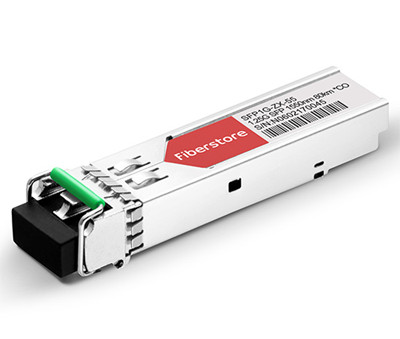
Figure 3 presents GLC-LH-SMD with LC connectors.
GLC-LH-SM-20
Cisco GLC-LH-SM-20 is the advanced version of GLC-LH-SMD, which operate at 1310nm wavelength through LC connector with a transmitting distance of up to 20km.
GLC-EX-SMD
GLC-EX-SMD is the Cisco 1.25Gbps SFP module that is compliant with 1000BASE-EX standard. It operates over 1310nm for distance up to 40km.
GLC-EX-SM1550-40
Compatible with 1000BASE-EX Gigabit Ethernet standard, this Cisco SFP also support a link length of 40km with DOM support. But unlike GLC-EX-SMD operating at 1310nm, this optical transceiver module works over 1550nm wavelength.
GLC-ZX-SM
As the name implies, Cisco GLC-ZX-SM is compliant with 1000BASE-ZX standard for single-mode fibers. When used in Cisco 2960 switch, it can support a link length of up to 70km at 1550nm.
GLC-EZX-SM-100
If the GLC-ZX-SM with a distance of 70km can not meet your network requirement, then you can use the GLC-EZX-SM-100 modules for 100km.
GLC-EZX-SM-120
GLC-EZX-SM-120 with a operating wavelength of 1550nm can reach up to 120km over single-mode fibers.
Conclusion
This article lists several Cisco SFPs with detailed specification, such as the media type, supporting distance, wavelength, operating temperature range, etc. If you have Cisco switches and don’t know how to choose the suitable SFPs, you can have a look through this article or directly visit www.fs.com.
Posted by: fernxu123 at
09:57 AM
| No Comments
| Add Comment
Post contains 545 words, total size 6 kb.
March 31, 2017
10G SFP+ optical transceiver is considered as the mainstream form factor of the 2017 market due to its matured technology and lower price, even although 40G/100G optical modules are on the very top trend for enterprise and data center for the interconnection. 10G SFP+ modules come in several standards: SFP-10G-SR, SFP-10G-LR, 10GBASE-ER SFP+, and 10GBASE-LRM SFP+. This article will offer details about the difference between SFP-10G-SR and SFP-10G-LR.

Cisco SFP-10G-SR
SFP-10G-SR is compliant with 10GBASE-SR standard. The Cisco 10GBASE-SR module supports a link length of 26m on standard Fiber Distributed Data Interface (FDDI)-grade multimode fiber, up to 300m link lengths over OM3 and 400m link lengths over OM4 cables.
Cisco SFP-10G-SR transceiver is hot-swappable input/output device which allows a 10 Gigabit Ethernet port to link with a fiber optic network. Because it is hot-swappable and MSA compliant, the Cisco SFP-10G-SR transceiver can be plugged directly into any Cisco SFP+ based transceiver port, without the need to power down the host network system. This capability makes moves, add-ons and exchanges quick and painless. The data sheet of SFP-10G-SR is as follows:

The Cisco SFP-10G-SR series consists of two other modules: the Cisco SFP-10G-SR-S Module and the Cisco SFP-10G-SR-X Module.
The Cisco SFP-10G-SR-S module belongs to the Cisco S-class optics that possess the same performance with Cisco SFP-10G-SR module. For the detailed information about the difference between Cisco S-class and non S-class optics, you can review the previous article.
Cisco SFP-10G-LR
The Cisco 10GBASE-LR module supports a link length of 10 km on standard single-mode fiber. Compliant with 10GBase-LR standard, SFP-10G-LR can support up to 10km over single-mode fiber and uses 1310nm lasers. There is no minimum distance for LR, either, therefore it is suitable for short connections over single mode fiber, too. The following image shows a Cisco Compatible SFP-10G-LR SFP+.

10GBASE-LRM SFP+
10GBASE-LRM is the type of transceiver that customers may easily feel confused with 10GBASE-LR SFP+ optics. However, in short, 10GBASE-LRM SFP+ still uses the 1310nm lasers, but it can only reach up to 220 m over standard multimode fibers (OM3/OM4). The 10GBASE-LRM can be packaged in XFP and SFP+ form factors.
Besides the Cisco SFP-10G-LRM, there are a new type of the 10G SFP+ module for multimode fibers—SFP-10G-LRM2. It is a type of SFP+ transceivers compatible with the 10GBASE-LRM standard. SFP-10G-LRM2 can reach up to 2km over standard multimode fiber.
Do You Need Cisco Original Brand or Compatible SFP+ Modules?
If you spend a large sum of money on the Cisco original brand switch, next you may think of buying the compatible optics. However, there comes the problem, do I need the Cisco original brand modules?
To tell the truth, not every SFP+ modules can work well on the Cisco switch SFP+ ports. You must make sure of the compatibility before plugging the SFP+ transceivers on it. Furthermore, SFP+ modules are the essential components of fiber optic network, usually, network installers need a bunch of them for your network deployment. Thus, select cost-effective 3rd party modules are necessary. You can also purchase more for back up.
FS.COM, as a reliable and qualified fiber optics supplier, supplies a full range of optical transceivers with a large quantity of products available in stock. Our compatible Cisco SFP-10G-SR and SFP-10G-LR modules are provided at really low price. Cisco SFP-10G-SR is $16, and SFP-10G-LR is $34.
Conclusion
SFP-10G-SR is mainly used for short-reach 10G application, while SFP-10G-LR, with a link length of 10 km is ideal for metro infrastructure. Customers can choose either reliable SFP-10G-SR or SFP-10G-LR, according to their own needs.
Posted by: fernxu123 at
09:25 AM
| No Comments
| Add Comment
Post contains 593 words, total size 5 kb.
March 22, 2017
There is the long-term debate between single-mode and multimode optics. From the data rate, link distance, and costs, people usually will calculate every single difference between them. However, this article will not talk about the technical distinctions because you can find the related information everywhere. Cost, as one of the important factors, is sometimes the deciding point by many data center operators.
The cost difference between single-mode and multimode optics (optical transceiver modules and fiber optic cables) are quite obvious. Single-mode optics with longer transmission distance and more bandwidth, usually charges higher than multimode optics. The following part will take FS.COM’s Cisco compatible single-mode and multimode optics as an example, and make a vivid comparison between these optics from 1Gbps to 100Gbps.
SMF Vs. MMF Modules
In order to cope with the ever-lasting requirement for higher data rate and reliable fiber performance, telecommunication industry launches a whole series of devices. Fiber optic transceivers, as a representative, developed from the old 1Gbps SFP module, 10G SFP+ (SFP plus), 40G QSFP+, to the 100G QSFP modules. The price gap of the single-mode and multimode optics in these form factors are huge but fluctuating.
- Cisco Multimode SFP Vs. Single-mode SFP

Seen from the above table, the price difference between multimode and single-mode SFP is minor.
- Cisco Multimode SFP+ Vs. Single-mode SFP+
SFP-10G-SR and SFP-10G-LR are the Cisco 10G SFP+ transceiver modules that can be operate over multimode and single-mode fibers, respectively. Cisco SFP-10G-SR price is only US$ 16.00 from FS.COM. And SFP-10G-LR price is US$ 34.00. The price gap between them is US$ 18.00. Different vendors may offer this products at different prices, but believe in me, FS.COM has the lowest price for optical modules.
- Cisco 40Gbps & 100gbps single-mode Vs. Multimode Modules
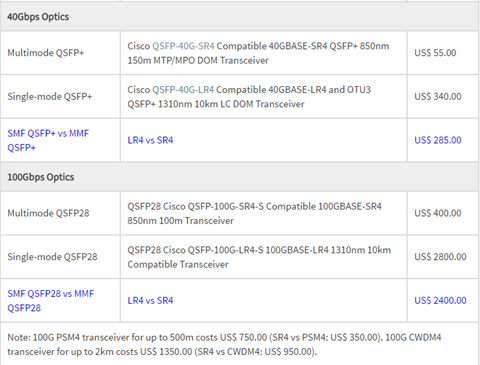
Keep in mind, the number listed above is only the price of specified optical module. For the budget of a whole network, you should also count the other essential components and the maintenance cost.
Single-mode Vs. Multimode Fibers
It is known to all that whether to use single-mode or multimode fibers depends on the fiber optic transceiver types. In this case, the cost difference between single-mode and multimode fibers also depends on what optics you use. For example, SFP-10G-LRM Cisco can only work with LC single-mode fibers, while Cisco QSFP-40G-SR4 needs to be connected with MTP OM3/OM4 multimode fibers. Obviously MTP multimode fibers charges higher than LC single-mode fibers.
Conclusion
This article has listed the price gap between single-mode and multimode optics. Single-mode optics averagely charges higher than multimode optics. Whether you go for the single-mode or multimode cabling are all feasible. Keep in mind that single-mode cabling is for long-hual and multimode is for short-reach applications. And a reliable fiber optic transceiver module manufacturer like FS.COM will save you a large sum of money.
Posted by: fernxu123 at
03:18 AM
| No Comments
| Add Comment
Post contains 473 words, total size 4 kb.
March 15, 2017
Top of rack switching as the basic data center architecture, requires one or two access switch installed on the top pf each sever rack, which provides easy cable management and maintenance. Additionally, it reduce the cable requirement as all sever connections are terminated to its own rack. Direct attach cables (DAC) twinax cable can achieve interconnection up to 15 m at 10 Gbps or 40 Gbps with low power. Most server gears come default with DAC twinax cables in-rack along with a couple of short-throw lasers back to core. This article will present the cabling solutions of the DAC cables for data center top of rack deployment.
Why Use DAC Twinax Instead of Cat5e or Cat6 Cables for Top of Rack Switching?
What media option would be the best to invest in for top of rack application? Category copper cable (Cat5e or Cat6) used to be the preferable options. Cat5e or Cat6 cables, standardized on 10GBASE-T, are overall cheap, backward compatible and much easier for cable management, especially for shorter cable runs. But these days, DAC twinax cables are more suitable for top of rack switching owing to the following reasons.
First, most of the hosts we are buying are not with RJ45 on board and all the switches and firewalls we’ve used for years were SFP+. Second, the extra power consumption for 10GBASE-T is higher than DAC cables. Additionally, DAC cables has lower latency hit. Last but not least, people often prefer DAC twinax owing to its flexibility. People can easy swap a DAC cable for a SFP+ transceiver and generally connect to anything I need to.
Note that the decision between Cat5e/Cat6 cables and DAC comes down to what your strategy for server hardware is, if you don't run high density servers, or you use blade enclosures to reduce your server port count, Cat5e or Cat6 cables might be fine and should be much cheaper.
DAC Twinax Cables
For interconnection in top of racks, the direct attach cable assemblies are used to connect server to switch, storage to switch or switch to switch. Just as the following image shows, DAC twinax cables, available in direct attach passive or active copper cable, active optical cable or breakout direct attach cable assemblies, can cope with different interconnection applications.
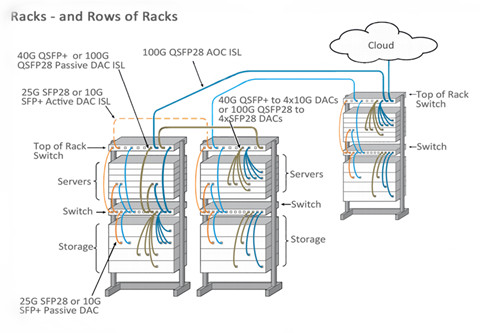
Copper twinax cable with various length options, are popular on the market. For example, 10G SFP+ DACs are commonly used in interconnect application below 15 m, e.g. server to switch or storage to switch interconnection in the same rack. SFP-H10GB-CU2M is the 10G SFP+ passive direct attach copper cable used for short-reach direct connection. And for 40GbE, 40G QSFP+ DACs and AOCs are used, the former is usually used for short-interconnection below 15 m while the latter is used for longer interconnect application that over 15 m but less than 100 m. Of course, higher speed and more bandwidth are needed for spine switches. 100G DACs, like QSFP28 DACs are used in this case.
DAC Twinax Used in Top of Rack Switching
FS.COM offers a comprehensive solution for data center ToR deployment including cables, transceiver optics and direct attach cabling products to satisfy various demands on data rate. Depending on different layers, we offer the different solutions:
- Use Case for Interconnecting Rack Servers and ToR Switch
For interconnection between rack servers and ToR switch within rack, the Category 6a (Cat 6a) Ethernet patch cables or SFP+ direct attach cables can be used. The cable length depends on the distance from the rack server to the ToR switch that is limited to the vertical height of the cabinet.
- ToR Switch to Network Switch
When connecting the ToR switch to network switch, it requires increased transmission speeds and distances. For distances below 15 m, the SFP+ direct attach cable is still an ideal option. But if the distances are more than 15 m, we recommend you to use the multimode fiber with the corresponding optics. In addition, for distances less than 100 m, the SFP+ AOC (active optical cable) is a viable option.
- Network to Core Switch
At the core of data center, direct attach cables designed with QSFP+ connectors can be used for short distance transmission of up to 15 m to support up to 40Gbps. To support distances above 15 m, the OM3 or OM4 fiber is recommended to use with the QSFP+ optics. In addition, for distances less than 100 m, the QSFP+ AOC is a viable option.
Conclusion
Twinax copper cables including the DAC and AOC cables are the mainly used cable type to support high transfer rates between servers, switches and storage devices intra rack or inter rack in a data center. This article has concluded the reasons why we should DAC cables and the cabling solution for top pf rack switching.
Posted by: fernxu123 at
01:45 AM
| No Comments
| Add Comment
Post contains 800 words, total size 6 kb.
February 28, 2017
Cisco Nexus 3500 Series switch are the comprehensive portfolio of 1, 10, and 40 Gigabit Ethernet switches to achieve exceptional layer 2 and 3 switching latencies of less than 200 ns. They are Cisco’s hot-selling switches that can support a series of Gigabit Ethernet transceivers like the SFP optical transceiver, SFP+, and the QSFP+ modules. Cisco Nexus 3500 Series Switches include various models such as Cisco Nexus 3048 switch, Cisco Nexus 3100 platform switches, Cisco Nexus 3100-V platform switches and Cisco Nexus 3200 platform switches. Today’s article will provide a clear description of this switch type along with the available Gigabit Ethernet transceivers.
Cisco Nexus 3500 Platform
Cisco Nexus 3500 series further extends the leadership of the Cisco Nexus 3000 series and uses the Cisco Algo Boost technology to achieve excellent Layer 2 and 3 switching. In addition, Algo boost technology offers several innovations in latency forwarding and performance visibility capabilities:
- Hitless Network Address Translation (NAT)—In many financial trading environments, trade orders must be sourced from the IP space of the provider, requiring NAT at the border between networks. But Cisco Nexus 3500 platform can perform NAT for IPv4 unicast routed packets without incurring any additional latency.
- Latency monitoring—The Cisco Nexus 3548x and 3524x enable users to finely control their environments to increase network performance. Customers can identify latency on a specific egress port through the command-line interface (CLI) and export this information to a file. The programmability of the Cisco Nexus 3548x allows users to use this information in real time.
- Active buffer monitoring—Even on the lowest-latency switches, data packets can incur a millisecond or more of latency during periods of congestion. In contrast, Algo Boost accelerates the collection of buffer utilization data in hardware, allowing sampling intervals of 10 ns or less.
- Cisco Nexus Data Broker—The Cisco Nexus 3500 platform switches with Cisco Nexus Data Broker can be used to build a scalable and cost-effective traffic monitoring infrastructure using network taps and SPAN. In addition, you can distribute these sources and traffic monitoring and analysis tools across multiple Cisco Nexus switches.
Cisco Nexus 3548 and 3524 Switches
Cisco Nexus 3548 and 3524 Switches are the two commonly used Cisco Nexus 3500 series switches. Cisco Nexus 3524 has 24 ports, while the 3548 enables the use of 48 ports. As seen in the below image, Cisco 3548 switch with 48 fixed SFP+ ports for 1, 10 Gigabit Ethernet enables the total switching capacity of 960 Gbqs. As part of the Unified Fabric Family, the Cisco Nexus 3548/3548-X Switch is well suited for mainstream top-of-rack, (ToR) data center deployments. It comes in a compact, 1-rack-unit (1RU) form factor.

Similarly, Cisco Nexus 3524 has the identical hardware as Cisco Nexus 3548. However, its software license is different from Cisco Nexus 3548 which only allows the operating of 24 ports. And its switching capacity is only 480 Gbps. If you want to active all the 48 ports of Cisco Nexus 3524, another license is required to enable the rest 24 ports.
Cisco Nexus 3548x and 3524x are the next generation switches. They keep the basic hardware structure as the previous generation, but consume 25 percent less power. They also introduce powerful hardware-based multicast NAT and latency monitoring capabilities and a second USB port for easier manageability.
Gigabit Ethernet Transceivers for Cisco 3500 Switches
Cisco Nexus 3500 series switches can support up to 40G Ethernet. For in-rack or adjacent-rack cabling, the Cisco Nexus 3500 platform supports SFP+ DAC copper cabling that combines the 10G twinax cables into an energy-efficient and low-cost solution. And for longer cable runs, multimode and single-mode optical SFP+ transceivers are supported.
- SFP+ Direct attach copper cables on Cisco Nexus 3500 switch
Cisco has listed several 10G SFP+ copper cables that can be used on Cisco Nexus 3500 series switches: SFP-H10GB-CU1M, SFP-H10GB-CU3M, SFP-H10GB-CU5M, SFP-H10GB-ACU7M, and SFP-H10GB-ACU10M. But if you think the original Cisco switches are too expensive, you can have a look at the compatible SFP+ twinax copper cables from FS.COM. Their 10g SFP direct attach copper cables are about US $10. Here provides a table of FS.COM compatible Cisco twinax DAC cable.

- Reliable 10g SFP+ transceiver
10G SFP+ single-mode or multimode transceivers are often used to support longer-reach applications. SFP-10G-SR (up to 300m) and SFP-10G-LR optics (up to 10km) are the two common types. For longer distance than 10km, you can also use the Cisco Cisco SFP-10G-ER and Cisco SFP-10G-ZR Modules.
- Compatible gigabit SFP optical transceiver
You can also realize the Gigabit Ethernet connectivity on Cisco Nexus 3500 switches by using the compatible gigabit SFP optical transceivers like Cisco GLC optics.
Conclusion
This article outlines the fiber cabling solutions for the Cisco Nexus 3500 series switches. Gigabit Ethernet transceivers as the SFP optical transceivers, SFP+ DAC cables and SFP+ transceivers from fs.com are fully compatible with the Cisco original devices. Please feel free to contact us.
Posted by: fernxu123 at
08:48 AM
| No Comments
| Add Comment
Post contains 817 words, total size 7 kb.
February 22, 2017
When purchasing the third party optics, customers usually suffer from the poor quality and compatibility issue, which is the major obstacle of OEM market. Just as a saying goes, what is good is not cheap. However, this article will prove that the cost-effective OEM optics from FS.COM are well worth the penny.
FS.COM, as a professional and reliable manufacturer and supplier of compatible optical transceiver, provides a series of self-developed products which can be highly compatible with many major brands, such as Cisco, HPE, Juniper, Brocade, Arista, etc. In this blog, we are going to present a compatibility testing of our hot-selling Cisco compatible QSFP-40G-SR4 optics on Cisco Nexus 9396PX.
Cisco QSFP-40G-SR4 Optics
Before we come to the major part, let’s have a brief overview of the 40G QSFP-40G-SR4 and the Cisco Nexus 9396PX switch. Cisco QSFP-40G-SR4 Compatible 40GBASE-SR4 QSFP+ transceiver is a short-range transceiver for 40 Gigabit Ethernet. It supports link lengths of 100m and 150m on laser-optimized OM3 and OM4 multimode fiber, respectively. Cisco QSFP-40G-SR4 enables high bandwidth 40G optical links over 12-fiber parallel fiber terminated with MPO/MTP multifiber connectors, which is also optimized to guarantee interoperability with any IEEE 40GBase-SR4 and 10GBase-SR.
Our Cisco compatible QSFP-40G-SR4 optics is fully tested with most Cisco platforms to ensure compatibility and compliance. Thus, it can be supported on a wide range of Cisco equipment, such as Cisco ASR 9000 series, Nexus 9000 series, Nexus 6000 series, and so on.
Cisco Nexus 9396PX Switch
Cisco Nexus 9396PX belongs to the Cisco Nexus 9000 series. It delivers a comprehensive line-rate layer 2 and layer 3 featuring in a two-rack-unit form factor. It can support 1/10/40 Gbps of switching capacity with forty-eight 1/10 Gigabit Ethernet SFP+ port and twelve 40 GE QSFP+ nonblocking ports. The main advantage of this switch is that you can reuse the existing 10 Gigabit Ethernet multimode cabling for 40 Gigabit Ethernet by connecting the 40Gb bidirectional transceiver. Figure 2 shows the Cisco Nexus 9396PX switch.

The Testing Procedure of the Cisco QSFP-40G-SR4 on Cisco Nexus 9396PX Switch
In FS.COM’s test center, we care of every detail from staff to facilities to ensure our customers to receive the optics with superior quality. Just take our hot-selling Cisco QSFP-40G-SR4 optics as an example, the procedure can be quite simple that can be concluded in three steps:
1. Plug the Cisco QSFP-40G-SR4 compatible QSFP+ into the 40-Gbps ports of the Nexus 9396PX
2. Plug the cleaned MTP patch cord into the optical ports of the transceivers
3. View the state of LED light and more information in the CLI.
Besides the above procedures, we also have a testing demo of QSFP-40G-SR4 Cisco compatible module testing on Nexus 9396PX.
ConclusionAt the end of the article, you must know the reason why FS.COM is the number one choice of compatible optical transceivers. Not only the Cisco QSFP-40G-SR4 optics, but other reliable compatible fiber optic transceivers from FS.COM are the best-seller products over the past years. If you are the major brand user like Cisco, HPE or Juniper, and want to cut down your budget this time, you might want to have a look at our cost-effective compatible fiber optic transceiver.
Posted by: fernxu123 at
08:10 AM
| Comments (3)
| Add Comment
Post contains 534 words, total size 4 kb.
45 queries taking 0.1224 seconds, 160 records returned.
Powered by Minx 1.1.6c-pink.








